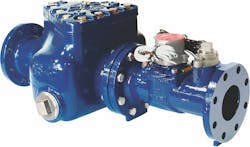Commercially Savvy
About the author: Doug McCall is director of marketing for Sensus. McCall can be reached at [email protected].
Nashville’s Metro Water Services (MWS) is an example of a utility that chose to upgrade its commercial meter fleet to better detect low water flows and for enhanced meter reading accuracy. As a result, MWS now is able to better track their customer water usage while also saving time and gaining peace of mind.
In just two years, MWS has increased revenue by capturing previously unmeasured low and high water flow. This return on investment is expected to continue to grow for MWS as the meters reduce head loss to save energy costs, require less maintenance and have a longer life-cycle.
The city of Sunnyside, Wash., experienced similar success after upgrading its commercial meters. A review of billing history revealed that large commercial customers accounted for approximately 70% of the city’s decreasing revenue. Sunnyside officials knew they had to change their system and infrastructure. Following a citywide meter testing program, the utility replaced all of its top 10 large meters, which impacted revenue.
“In the past, we didn’t treat our commercial meters any differently than residential meters,” said Jim Bridges, director of public works for the city of Sunnyside. “Since we embarked on an aggressive schedule to test all of our large meters once a year, not only has our revenue increased, but we have also reduced unaccounted-for water from 10% prior to our testing program to just 1% or 2%.”
The role of city and municipal water department managers is more important than ever before; however, revenue for water utilities is circling the drain, both literally and figuratively. In fact, a survey of water utilities worldwide revealed that utilities lose an estimated $9.6 billion in revenue each year due to undetected water leaks. The potential loss of both water and revenue is driving cities and utilities to invest in technologies that turn the tide on these challenges.
Capturing Water
The question is, how can water utilities capture the water and revenue they are losing? One approach is to deploy water meters and emerging smart water network technologies equipped to capture low flow, maintain accuracy over time and report leaks.
The commercial water meter industry is saturated with meters designed to withstand the high water flow used by commercial water customers. Yet many of these meters miss the mark on measuring low water flows. For example, the low water flow used by commercial grocery stores to mist their produce often is not captured, and subsequently, not paid for. Eventually, these low flows add up to big dollars. Given that commercial meters typically account for 50% or more of a water utility’s revenue, the losses can be significant. To conserve water and capital, water utilities must address the accuracy of their meter fleets.
Preventing Maintenance
It is imperative that commercial meters boast low flow and high flow accuracy throughout the lifespan of the device. Utilities today need commercial meters that have the precision to capture low flow water usage and the durability to measure high flows with a gold-standard accuracy range—all while avoiding wear to the meter. Flow capture is important; however, durability also is key to saving money because durable meters require less maintenance and fewer onsite visits from utility personnel.
Innovations in commercial water metering technology like floating ball technology (FBT) can help provide optimal measurement performance for commercial meters. For example, FBT employs an impeller with a ball design to make the impeller weightless in the water line, enabling the impeller to begin moving with little water flow or force through the meter. As a result, FBT provides an extended flow range with better low flow sensitivity and an ability to capture extended high flow rates with no wear.
Enabling Leak Detection
As water metering technology continues to advance, a meter’s ability to work well with other technologies, particularly those found in smart water networks, is just as important as durability and pinpoint accuracy. Commercial water meters are part of a smart water solution that combines the metrology-based smart point with two-way communication for automation and leak detection.
A key component of a smart water network is advanced metering infrastructure (AMI), which provides a communications network designed and built specifically for smart water networks. AMI has changed the way utilities generate, manage and deliver water. It all starts with a meter capable of accurately detecting low flow water usage, but it becomes even more powerful when paired with AMI. Water utilities lose revenue each year through low flow leaks that go undetected. Through innovations like FBT and AMI, water utilities are able to track and get alerts about continuous low flow.
Utilities are continuing to embrace new technology that provides a return on investment—and smart water networks that impact reliability, durability and water flow measurement are a sure bet.
Download: Here
